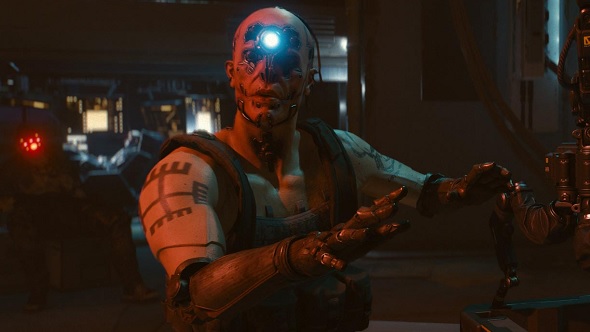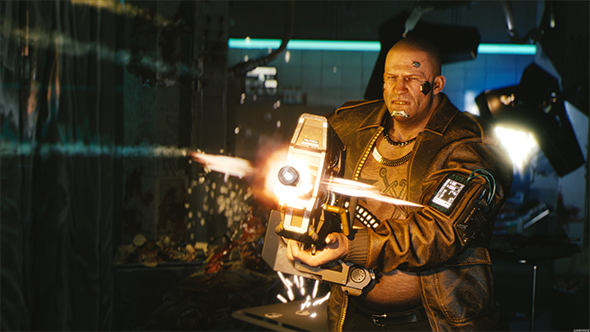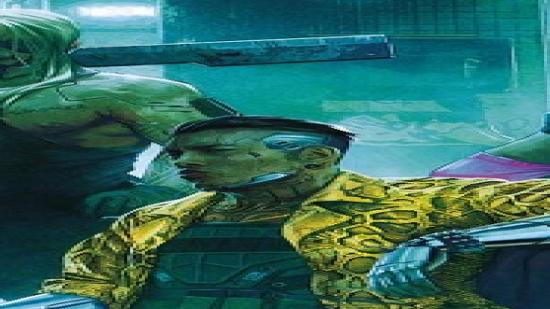Cyberpunk is back in the spotlight like never before. Blade Runner was undoubtedly a peak for the sci-fi sub-genre but anticipation for CD Projekt Red’s first-person RPG Cyberpunk 2077 suggests it’s about to be topped. People crave the game like a dilapidating android chasing down a new cybernetic implant.
But not everyone is enthralled with it. William Gibson helped to invent cyberpunk with his 1984 novel Neuromancer – its gritty depiction of a plugged-in future was a revelation, winning it a slew of literary prizes and resulting in more than six million sales to date. Gibson wasn’t impressed with Cyberpunk 2077’s E3 2018 trailer. He made this clear by taking to Twitter to say that it “strikes me as GTA skinned-over with a generic 80s retro-future.” Ouch.
CD Projekt Red had already made one of the best RPGs on PC. Will this be another?
A similar sentiment comes from Bruce Sterling, one of Gibson’s fellow cyberpunk founders, who says he can “admire the technical quality of that trailer,” but reckons “it’s got the same problem that DC and Marvel movies have.” By which he means it’s too glossy, too interested in being pretty, and doesn’t do anything new.
There’s a contradiction at the heart of modern cyberpunk that stems from it being sucked into mainstream culture. What was once a celebration of the techie underground – its hackers and misfits – is being repackaged and sold to us by the corporations that cyberpunk tells us to fight against. Mike Pondsmith, creator of tabletop-RPG Cyberpunk 2020 – the source of CD Projekt Red’s videogame adaptation – also recognises that cyberpunk’s visual style has been co-opted by suits. He recalls seeing an advert in the early 2000s for “some corporation like Apple” that slavishly copied the style of Blade Runner: “What had happened was those visuals had become symbolic with cool, and so the megacorps had begun to absorb those images.”
However, Pondsmith maintains that the philosophy and worldview of cyberpunk retains its outsider credentials, even if the visuals don’t. “This is one reason I think that Blade Runner 2049 [failed to break even at the box office]: it wasn’t just about what it looked like, it was also making you think about things you probably didn’t want to think about.”
Through mirrorshades, darkly

Cyberpunk is certainly having a renaissance at present, but it’s confused – separated from the context it originally emerged in, it’s been warped so that it’s more an aesthetic than anything deeper. Stop to consider it for a minute and a few questions emerge: what qualifies as cyberpunk today, what does it mean, and what will it become? To find the answers you need look to at what cyberpunk was when it started out.
Both Gibson and Sterling were around at cyberpunk’s beginning, when it was nothing more than a mailing group comprised of authors who circulated ideas on the fast-moving world of technology – distancing themselves from the shiny space-age futurism of previous decades. “We used to photocopy a lot of newspaper and magazine articles about tech development, futurism, samizdat, punk DIY tech, cities, globalisation, new materials, the military,” Sterling says.
These writers latched onto the idea of corruption through technology, and often dealt with the same immediate period that English novelist J. G. Ballard (a favourite among the cyberpunk authors) explored: “the future of the next five minutes,” as he put it. They were concerned with the seeds of the technological future being sown in the present.
Another significant influence on these seminal cyberpunk authors is the novel Do Androids Dream of Electric Sheep? by Philip K. Dick. Published in 1968, the novel explores a future in which android replicants are near-perfect copies of humans, blurring the line between the biological and the machine: “the electrical things have their lives, too.”
The efforts of this group culminated in 1986, with the short story anthology Mirrorshades – a compilation of sci-fi tales compiled and edited by Sterling. “We didn’t call ourselves ‘cyberpunks’ – that label got stuck on us by a critic named Gardner Dozois,” Sterling tells me.
It was then that cyberpunk became a literary sensibility – one that had plenty of followers but struggled to find a definition. “We had some bumper-sticker slogans people liked. ‘The future is already here, just not well-distributed’, ‘High tech and low life’, ‘The honesty of complete desperation’,” Sterling says. “If you were the kind of guy who would read something like that and think ‘Huh, maybe they’re right’, then you were a cyberpunk sympathiser.”
Jacking in

Pondsmith is one such sympathiser. He first encountered cyberpunk through the theatrical release of Blade Runner in 1982 and was later enthused by it again when reading the 1986 cyberpunk novel Hardwired by Walter Jon Williams. It was enough for him to start working on Cyberpunk, his tabletop-RPG that took heavily from these influences, and in a more direct way than Pondsmith had initially anticipated.
“A friend of mine happened to be running a Repton giant robot game, and it turned out that one of the people in his game was Walter Jon Williams,” he says. “So after fanboying out a bit, I started talking to him, and I said I wanted to do something along the lines of what he was doing with Hardwired. So Walter ended up being the first science fiction writer in the crew to actually play my early prototype of Cyberpunk.”
Gibson became a big influence on the Cyberpunk tabletop game about six months into its development too, when Pondsmith read Mona Lisa Overdrive: “I remember shaking my wife awake and saying ‘this guy’s stuff is so good it makes my teeth hurt!’,” he recalls.
Released in 1988, Cyberpunk was a big hit for Pondsmith’s company, R. Talsorian Games, and was followed by a second edition, Cyberpunk 2020, in 1990. He thinks its popularity is partially down to its appeal to outsiders, which “in a way mirrors how I’ve seen life for myself,” but also that there’s an “inherent kind of power fantasy in 2020.”

He puts this down to the fact that high-level technology is freely available in this world, “so that means that while there may be corporate assassins and bad guys out there, the ubiquity of the technology means that you might be able to get a hold of that same capability and use it… In Cyberpunk we offer you the hope that if you are badass enough, tough enough, and willing to cyber up enough, you can make a difference, you can have an effect.”
While Pondsmith is influenced by the original cyberpunk authors, his working definition of the sub-genre differs from theirs. He divides cyberpunk into two overarching ideas. The first is that it’s set in a “craptastic world” where technology has not worked out for us.
“We established the idea when I was a kid that technology was going to be guys in white coats leading us into the future,” Pondsmith says. “But the technology in cyberpunk is ubiquitous, and it’s not controlled by guys in white lab coats, it’s now at the street level, and the street is able to find its own uses.”
He also cites regular citizens not having any control over their lives as another defining aspect of cyberpunk. “There’s not even an illusion of control,” Pondsmith says. “Powerful forces, whether they be governments, corporations, individuals, all have the power ostensibly arrayed against you, and you’re fighting for your life and the way you want to live. And that’s very important because it means that it’s a personal thing.”
Blurring realities

This idea of an uprising in cyberpunk is what mainstream media based on it has focused on most, packaging and selling it as a power fantasy. The 1999 smash-hit film The Matrix is one of the most widespread purveyors of this form of cyberpunk, alongside its videogame adaptations, but it was beaten to the punch by the likes of Syndicate, System Shock, Shadowrun, and soon after Deus Ex. There was even an early game version of Neuromancer itself.
Cyberpunk has an especially long reach in videogames perhaps due to their virtuality easily meshing with the cyberpunk ethos. The relationship even extends to Neal Stephenson’s hugely influential 1992 novel Snow Crash, and its depiction of a networked world, which went on to inspire the creators of Xbox Live, as well as popularise the widely-used gaming term ‘avatar’.
But the influence of cyberpunk in the today’s world goes far beyond videogames and movies. The technologist and policy analyst Vinay Gupta thinks cyberpunk has directly influenced our reality. In a talk about the promise of blockchain, he argues that the programmers who created it and other net-based technologies were very much influenced by the cyberpunk stories of the 1980s.
“If you want mental models of how to think about the reality we’re currently in, you have to go back to the science fiction of 30 years ago published under a general [genre] of cyberpunk… a fiction that describes the reality we’re now in. It’s about virtual reality, it’s about drones, it’s about biotechnology that reroutes your nervous system, it’s about virtual currencies and artificial intelligence.”
Gupta points to Mirrorshades in particular and adds that by reading early cyberpunk “you can begin to flesh out the stories that all of the programmers had in their heads when they built these technologies, and that’s how you get your head around what’s happening [today].”
He’s not wrong. There’s little difference between our current reality and the cyberspace dreams Gibson and his contemporaries wrote about in the 1980s. Virtual reality has arrived, the top five giant tech corporations are worth nearly $3 trillion, AI has made its way into everyday homes via Google’s Home and Amazon’s Alexa, and national governments are even using AI to autonomously defend against cyber attacks. And, as cyberpunk predicted, the ubiquity of technology has seen it turn into a double-edged sword, as likely to hinder us as it is to help – think about this the next time Alexa dims the lights instead of playing that jazz playlist you asked for.
Where does cyberpunk go now?

If we’re living in the cyberpunk future depicted in the 1980s then this raises questions about its purpose in modern culture. Cyberpunk is meant to predict the tech futures we’re about to spill into – and as we already occupy the years that the original vision was concerned with, surely it needs to move past that iconography and the ideas its authors originally formulated. Thisis the problem Gibson has with Cyberpunk 2077’s trailer: it is stuck firmly within the 1980s worldview of cyberpunk. But should we really expect cyberpunk to move beyond that – and would it hold the same appeal if that were to happen?
“The future for cyberpunk is the same as the future for science fiction generally,” Sterling says. “The particular objects or tech toys that get valorised, they change a lot with time – for Jules Verne it was hot-air balloons and for us cyberpunks it was desktop computers.” Sterling doesn’t see cyberpunk evolving much from its neon-heavy aesthetic, nor does he see change for the topics it tackles, but he believes the “conceptual vitality” of cyberpunk will be cherished by future generations, much like Verne’s classic novels are today.
Pondsmith agrees with Sterling to an extent but, unsurprisingly given that he’s working on the game, he sees worth in Cyberpunk 2077 rehashing ideas from 30 years ago for a new audience. “Cyberpunk 2020 is as much of a cautionary tale as it is a setting,” Pondsmith says. “It’s ‘do you really want to live in this world’? And before you think ‘oooh, flying cars and neon and walking around in big ragged coats’, think about what this means for your day to day, think about what this world means.”
Publishers have been vying to make a videogame version of Cyberpunk 2020 for years but Pondsmith had always turned them down: “they just didn’t get the gag about how the world worked and how the politics worked, how it’s structured,” he says.
The reason he went with CD Projekt Red was simply because the team proved to be dedicated fans of the roleplaying game. “When I went up to see them, they could quote me chapter and verse of characters they wanted to have in it, and groups and organisations and events,” Pondsmith tells me. “So unlike many of the people who wanted to do Cyberpunk as a videogame, CDPR got it because they liked it, loved it, had lived it.”
Working with the new setting of 2077, Pondsmith has been consulting CD Projekt Red – referring to his role as the “vision holder” – to ensure it’s faithful to Cyberpunk 2020 while also advancing parts of its fiction to reflect the jump forward in the timeline. He visits the studio two or three times a year to point them in the right direction, helping to adapt the huge volumes of background lore provided with the original tabletop game so that it resonates better with people of today.
When that Cyberpunk 2077 release date rolls around cyberpunk’s old guard probably still won’t be impressed, then. But it’s the best chance for the sub-genre to engage with new, younger audiences, and to bring its warning to the generations who find themselves actively living in the cyberpunk future that the writers of the 1980s foresaw.
